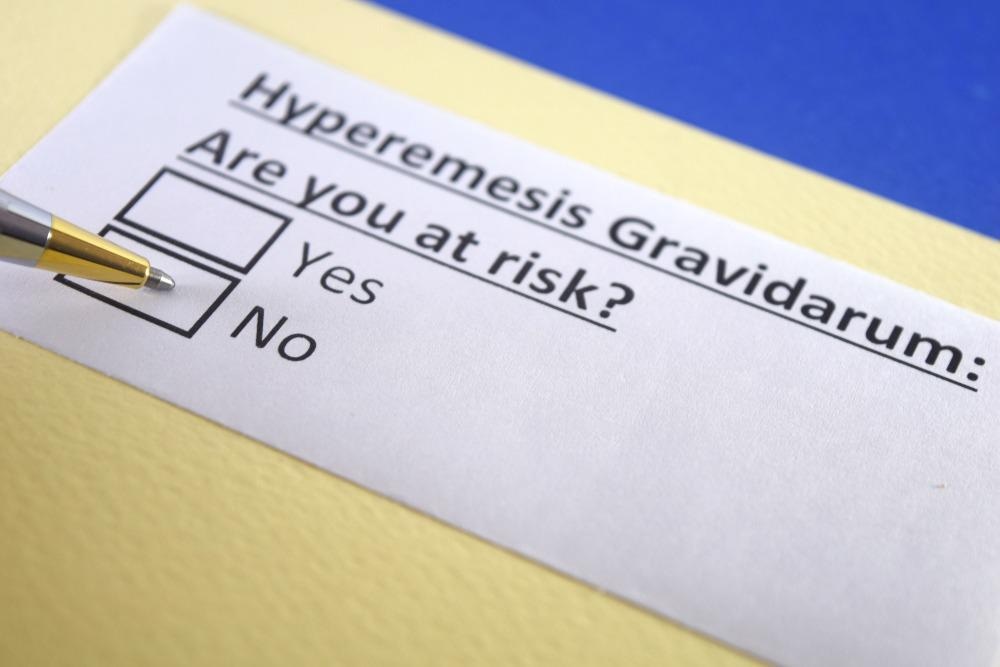I am a Research Professor of Obstetrics and Gynecology at the University of Southern California, a Board Member of the Hyperemesis Education and Research Foundation, and a consultant for Materna Biosciences, Inc.
I have a Ph.D. in genetics and my work focuses on diseases of women. I started to research HG after being totally bedridden and unable to eat for 10 weeks, ultimately losing a baby at 15 weeks gestation to the disease in 1999.
Please can you explain hyperemesis gravidarum (HG) and how it can affect the health of both pregnant women and their infants?
Most pregnancies are affected by nausea and vomiting, but HG lies at the severe end of the clinical spectrum. People with HG start having severe symptoms of nausea and/or vomiting early in pregnancy that strongly limits their ability to eat and/or drink and function normally. HG usually leads to dehydration, nutritional deficiencies, electrolyte disturbances, and weight loss. There can be significant maternal and fetal morbidity and even mortality.
The people in my study have reported detached retinas, pneumothorax, esophageal tears, and rib fractures from the violence of the vomiting. Studies show 32% contemplate suicide and 18% have PTSD from the prolonged traumatic experience. Brain damage and maternal deaths continue to be reported secondary to severe nutritional deficiencies, electrolyte disturbances, thromboembolism, and thyrotoxicosis.
In addition, there is now substantial evidence to support adverse outcomes. Babies exposed in utero to HG have a 5-fold higher risk of being born small for their gestational age. This is a higher risk than prenatal exposure to cannabis, tobacco, amphetamine, cocaine, as well as maternal chronic hypertension, pre-gestational diabetes, preeclampsia, and autoimmune disease. Despite this, symptoms of HG continue to be trivialized and patients are often left undertreated. Babies exposed to HG are at increased risk of preterm birth, low birth weight, smaller head circumference, decreased brain size, neurodevelopmental delay, vitamin K deficient dysmorphology, and autism spectrum disorder. In the case of HG, the baby is not always getting everything it needs from the mom.

Image Credit: Yeexin Richelle/Shutterstock.com
Why do you think HG has been so poorly understood and treated? With research like yours making breakthroughs, is the future looking better?
In the 1950s and 60s over 10,000 mothers with severe pregnancy nausea and vomiting were treated with thalidomide and their babies were born with limb deformities. This tragedy understandably dissuaded researchers, pharmaceutical companies, doctors, and patients from studying, developing, prescribing, and taking medications in pregnancy. But there is also the problem of misinformation.
Doctors continue to this day to be taught outdated theories that are not backed by science. There is clearly a misogynistic component to it too- the idea of the “hysterical pregnant woman” persists, resulting in a disconnect between HG patients and providers that contributes to pregnancy termination of wanted pregnancies.
Our research identifying the gene coding for the nausea and vomiting hormone GDF15 as the greatest risk factor for HG provides validation for people suffering from this condition. But more than that, it gives us a direction to focus on to develop new and hopefully more effective treatments.
Previous theories for the cause of HG have been based on psychological explanations and the hCG hormone. What were these theories and have you discounted them?
People have often focused on the pregnancy hormone hCG because it rises and falls in the first trimester when nausea and vomiting normally occur. However, evidence continues to be controversial with many studies showing no correlation between circulating hCG and HG. Genome-wide and exome-wide association studies are unbiased with respect to all genes in the genome. These techniques were used to identify genetic variants that are significantly different between cases with HG and cases with normal or no nausea.
There are genes known to be associated with psychological disorders and there are genes coding for the hCG hormone as well as its receptor and these, like all genes, were included in the studies. None of the genes encoding the hCG hormone were found to be of significance. Two hundred and eighty-nine variants on chromosome 19 were of greater significance than the most significant variant coding for hCG, including the top GDF15 variant that was the focus of our new study as well as five additional variants in GDF15 that did not reach exome-wide significance. In addition, 2 studies measuring circulating levels of hCG and GDF15 in pregnancies affected by more severe nausea and vomiting/HG found a significant association between GDF15 and not hCG.
As for the psychological hypothesis, a search of 4220 GWASes for GDF15 associations did not identify any personality traits but did identify protein levels, periodontitis, and lupus. The GWAS catalog contains over 400 genetic associations for anxiety disorder and over 2000 genetic associations for depression, and none of these are in the GDF15 locus.
Anxiety and depression may be a consequence of prolonged illness and starvation in pregnancy, but suggesting this is the cause of HG, rather than a consequence, can be harmful and is not supported by our studies. It is time to stop wasting resources on hCG and psychological factors as causal and focus on the GDF15 pathway.
How could abnormalities in the GDF15 gene be resulting in HG?
We are now in the process of studying this, as there are many ways genetic changes can contribute, for example via increasing circulating levels of GDF15 or increasing signaling by the hormone. Of note, a GWAS study of variants associated with increased serum levels of GDF15 found the same common variant we recently identified associated with HG. The placenta normally produces a huge amount of GDF15. Therefore, the variant may lead to an increase in the GDF15 hormone levels produced by the placenta that then travels to the brainstem and over activates the nausea and vomiting center of the brain.
We also know that GDF15 is a cellular stress signal that is increased when organs are under physical stress, when people are nutrient deficient, and when people have thyroid dysfunction. These are all states that can be consequences of HG pregnancies. Therefore, one can imagine that if you carry a genetic predisposition to slightly increased GDF15 levels, this can ultimately result in a downward spiral toward extreme nausea and vomiting.

Image Credit: PR Image Factory/Shutterstock.com
How did you identify the link between the GD15 gene and HG and how has your work confirmed and built on the previous breakthrough in this area?
Originally we partnered with the personal genetics company 23andMe and performed a genome-wide association study (GWAS) on their customers who volunteered to participate in a pregnancy survey. We compared the DNA between 1,306 cases with HG and 15,756 unaffected controls. In that study, we identified the novel association between HG and DNA variation around the gene that codes for the nausea and vomiting hormone GDF15.
Paradigm-changing findings often require additional evidence to gain broad acceptance in the field. Our new study, recently published in BJOG, used a different genetic technique, whole-exome sequencing (WES), on a different population of pregnant people (926 HG cases and 660 unaffected controls), and in the WES, a genetic variant in GDF15 was again identified, confirming previous results. The WES study also included patients of different ancestries, whereas the GWAS only included participants of white European descent.
In addition, WES can be used to identify rare mutations in genes. And in the WES study, the only gene with a mutation in 10 or more patients was a mutation in GDF15. In related studies, we, and others, have shown that in maternal serum, GDF15 levels are significantly increased in hospitalized HG cases, in patients with second-trimester vomiting, and those prescribed antiemetics. Lower levels of GDF15 are associated with no nausea and vomiting of pregnancy, which is also uncommon.
Variants in GDF15 have been associated with familial and recurrent HG, and with the level of circulating GDF15. The hormone is shown to cause taste aversion, appetite loss, and weight loss through the activation of the nausea and vomiting center of the brain in animal models. Taken together, there is now more evidence that GDF15 is involved in the etiology of HG than anything else.
How does this mechanism relate to cancer cachexia and how could this relationship benefit the future of HG treatment?
About 20% of cancer patients die from cancer cachexia, which is a condition with strikingly similar symptoms to HG, characterized by appetite loss, weight loss, and muscle wasting. GDF15 is produced by some tumors, circulates at abnormally high levels in patients with cancer cachexia, and causes cachexia in animal models. There are currently several drugs in development and clinical trials in cancer patients that block the GDF15 signaling pathway. If successful and safe in pregnancy, these drugs may be a game-changer for HG.
Via practices such as genetic testing, this knowledge could be used to improve the prediction and diagnosis of HG. How do you think this could all be implemented into the clinical setting, and how could it affect pregnancies around the world?
Pregnant patients often don’t see their doctor early in pregnancy when HG starts, and generally, doctors do not screen for HG during prenatal visits. Some patients are unaware that their symptoms require treatment until they end up in the hospital severely dehydrated and malnourished. Tools to predict and diagnose HG can be useful so that patients at increased risk can have earlier and more consistent care, which may lead to less need for emergency room visits, hospitalization, and limit adverse maternal and child outcomes.
In addition, 4 out of 5 people with HG have a recurrence. The high recurrence risk and severity of disease often disrupts family plans. If we can use genetic markers to predict who is more likely to have a recurrence, this may be very helpful in planning and preparing for subsequent pregnancies. However, these tests are a ways off because resources are scarce for creating and getting approval for use in a clinical setting.
What implications could this research and improved understanding of HG have on HG sufferers and their infants in the future?
In the short term, understanding that there has been progress toward understanding the biological basis of HG can be comforting to patients and their families. In the long run, I hope that it will lead to better tools to predict, diagnose, and treat the disease, ultimately resulting in healthier mothers and babies.

Image Credit: Natalia Deriabina/Shutterstock.com
Achieving adequate maternal health and ending preventable maternal deaths is a fundamental goal in improving healthcare around the world. How does your research support the global agenda to improve maternal health for all?
Approximately 70% of pregnancies are affected by nausea and vomiting, and HG has been reported to occur in 0.3-10.8% of pregnancies. Maternal deaths secondary to HG have been reported in this century in the US and UK. Progress in understanding the etiology of HG will hopefully lead to better prediction, earlier diagnosis, and treatment, and limit avoidable maternal deaths.
In addition, the research sheds light on a mechanism that results in undernutrition in pregnancy. One can imagine that in the future, similar to prenatal vitamins, medications targeting the GDF15 pathway, may work to improve overall nutrition in early pregnancy, leading to healthier mothers and babies.
Where can readers find more information?
About Dr. Marlena Fejzo
Marlena Schoenberg Fejzo, Ph.D., is an American medical scientist and professor of research on women’s health. She received her undergraduate degree from Brown University in Applied Math in 1989 and a Ph.D. in Genetics from Harvard University in 1995. After her postdoctoral studies on breast cancer at UCSF, she had joint appointments at the University of Southern California and the University of California, Los Angeles where she worked in the laboratory of Dr. Dennis J. Slamon until 2020. 
Currently, she researches HG at the University of Southern California, is on the Board of the Hyperemesis Education and Research Foundation and is a consultant for Materna Biosciences, Inc. She has published peer-reviewed scientific articles on many diseases of women including ovarian cancer, breast cancer, multiple sclerosis, and discovered the first genes for uterine fibroids, nausea and vomiting of pregnancy, and hyperemesis gravidarum.
She was an invited speaker at a congressional briefing during women’s health week and multiple international conferences and has been interviewed for documentaries, podcasts, radio shows, and news outlets around the world about her work on HG.